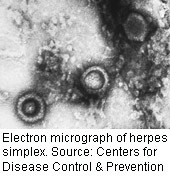
WEDNESDAY, July 7 (HealthDay News) — U.S. scientists believe they are getting closer to understanding how the herpes simplex virus invades cells, potentially providing a target for new drugs to fight the virus, researchers say.
The scientists used advanced imaging technologies to learn more about the structure and function of the cell-entry protein complex used by the herpes simplex virus type 2 (HSV-2), which causes genital herpes.
Complications of this sexually transmitted disease include recurrent painful genital sores, mental distress and, if transmitted from mother to child, potentially fatal infections in newborns.
The new research may “help us answer some of the many questions about how herpes virus initiates infection,” first author Tirumala K. Chowdary, a postdoctoral associate at Tufts University School of Medicine, explained in a university news release. “Knowing the structures of cell-entry proteins will help us find the best strategy for interfering with this pervasive family of viruses,” she said.
The study was released online July 4 in advance of publication in an upcoming print issue of the journal Nature Structural & Molecular Biology.
“Most viruses need cell-entry proteins called fusogens in order to invade cells,” explained senior author Ekaterina Heldwein, an assistant professor in the molecular biology and microbiology department at Tufts.
But the herpes virus also requires a complex of two other proteins to aid its entry into the human cell. It was thought that these proteins were also fusogens, but the new research shows that they are not, Heldwein said.
This unexpected finding suggests that these proteins may help regulate the fusogen. The team noted that certain antibodies appear to interfere with the activity of this complex, and this is “evidence that antiviral drugs that target this interaction could prevent viral infection,” Heldwein explained.
More information
The U.S. National Institute of Allergy and Infectious Diseases has more about genital herpes.

